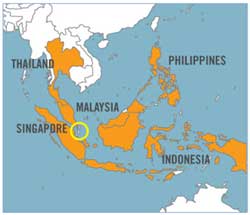 |
With the first quarter of 2014 now in the record books, it’s a good time to revisit the trends — and trend reversals — in key global markets.
If domestic investors expected a continuation of last year’s robust stock market gains, most will be disappointed when they open their quarterly brokerage statements.
The Dow Jones Industrial Average declined 0.9 percent in the first quarter, while the S&P 500 Index gained a scant 1 percent. In other words: U.S. stocks essentially went nowhere over the last three months, but not without plenty of volatility along the way.
The best-performing stock market sectors had a defensive flavor, with healthcare stocks up 4.5 percent and utilities gaining almost 9 percent.
Meanwhile, the best performing sector by far during this bull market, consumer discretionary, posted the worst performance last quarter, down 3.4 percent, with retailers and auto-related stocks hit hardest.
This reversal of fortune among U.S. stocks and sectors is also playing out globally.
As I pointed out previously in Money and Markets, the worst performing investments in 2013 easily fit into two broad categories: anything related to commodities and emerging markets.
But select commodity and emerging market stocks are among the leaders so far in 2014!
Commodity comeback
The Commodity Research Bureau Spot Index is up 8.2 percent year to date. I consider this index to be the best gauge of overall commodity prices because it’s a more even-handed measure of 22 basic commodity prices that are very sensitive to changes in the economy and business cycle.
Drill down inside the broad index and you’ll see that agricultural commodities (wheat, corn, soybeans) are the biggest winners, up 15.4 percent this year, followed closely by livestock, which is up 14.7 percent.
The high-profile commodities are a mixed bag, with gold up 6.4 percent year-to-date, while energy is down 1.2 percent.
There has been a lot of talk in the media about how “official” inflation is practically non-existent — the Fed for instance wants higher inflation — but basic commodity prices are telling a very different story in my view.
Here in the real world, the cost of everything from steaks to Starbucks coffee is going up. The Fed should be careful what it wishes for.
Emerging market rebound
Like commodities, emerging markets were a terrible place to invest over the past year, as the MSCI Emerging Market Index declined 2.8 percent in 2013, while the S&P 500 gained 28.4 percent.
But what a difference a few months can make.
So far in 2014, U.S. stocks are struggling while several emerging Asian markets are going through the roof.
* India is up 10.2 percent …
* Thailand has gained nearly 8 percent, and …
* Indonesia has surged 22.7 percent year-to-date.
And it’s easy to see why: Gross domestic product growth for emerging markets is on pace to expand 5.1 percent this year … that’s twice as fast as the major developed economies including the U.S., Europe and Japan, which will grow just 2.2 percent.
Emerging Asian markets in particular, including China, India, Indonesia, Malaysia, and the Philippines enjoy an even faster pace of growth, with GDP expanding 6.7 percent in 2014, as you can see in the graph below.
This is orders of magnitude above lackluster growth in the U.S., Europe and Japan.
And as I pointed out last week in Money and Markets, global capital flows have turned bullish for select emerging markets, with investors pouring money into Asian markets in search of better growth and profit potential.
One of the most dynamic regions for growth in Asia is known as the Association of Southeast Asian Nations (ASEAN). Member countries include: Singapore, Malaysia, Indonesia, Thailand, and the Philippines.
These nations enjoy strong and growing trade ties with China and India, helping to accelerate their own growth. Recently, the ASEAN region overtook Japan as China’s third-largest trading partner, with total trade surging 22 percent annually since 2002.
In fact, the ASEAN nations are among the very few that enjoy a trade SURPLUS with China. The region should become China’s top trading partner by 2015 with total trade exceeding $500 billion, but it’s not just exports.
 |
| The Fast Growing ASEAN Region |
ASEAN nations are also thriving thanks to fast-paced domestic demand. By 2015, the region’s middle class should reach 300 million consumers, nearly the entire U.S. population, driving strong and sustainable internal growth.
Investors with a global outlook may want to consider these faster-growing Asian markets. All of the ASEAN nations shown above are easy for U.S. investors to access using a handful of liquid ETFs listed on domestic stock exchanges.
Good investing,
Mike Burnick
P.S. For a list of my favorite emerging market ETFs, jump over to the Money and Markets Facebook page.

 Mike Burnick, with 30 years of professional investment experience, is the Executive Director for The Edelson Institute, where he is the editor of Real Wealth Report, Gold Mining Millionaire, and E-Wave Trader. Mike has been a Registered Investment Adviser and portfolio manager responsible for the day-to-day operations of a mutual fund. He also served as Director of Research for Weiss Capital Management, where he assisted with trading and asset-allocation responsibilities for a $5 million ETF portfolio.
Mike Burnick, with 30 years of professional investment experience, is the Executive Director for The Edelson Institute, where he is the editor of Real Wealth Report, Gold Mining Millionaire, and E-Wave Trader. Mike has been a Registered Investment Adviser and portfolio manager responsible for the day-to-day operations of a mutual fund. He also served as Director of Research for Weiss Capital Management, where he assisted with trading and asset-allocation responsibilities for a $5 million ETF portfolio.
{ 1 comment }
HOW IS COFFEE DOING ON WALL ST? IS IT STILL THE #2 MOST TRADED?